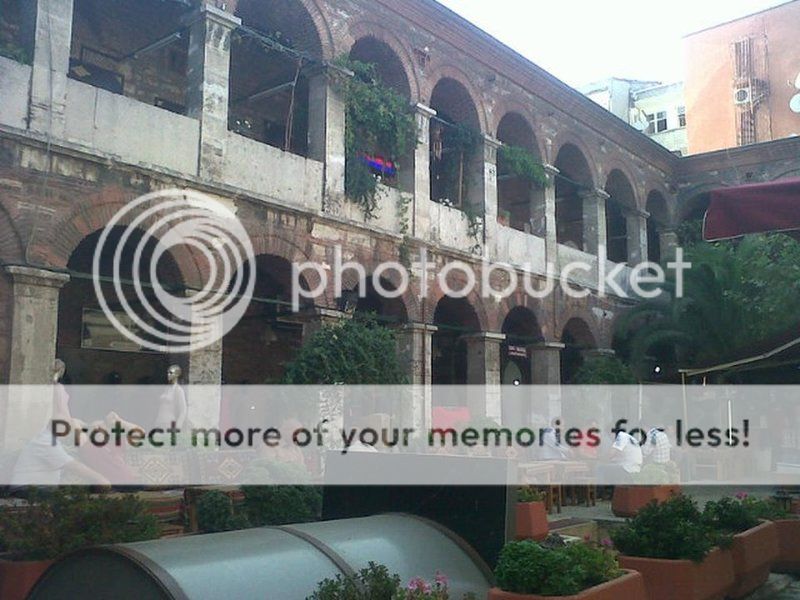GPS : 41°00'38.5"N 28°57'23.2"E / 41.010694, 28.956444

PHOTOGRAPHS ALBUM
The historical Taşhan, which was built by Mustafa III in 1763 in Istanbul's Laleli district as a hotel, has served numerous purposes throughout its history: a cistern, a brothel, a horse shed, a barrack for the Ottoman janissaries and, until the 1990s, a timber depot. It has been called various names: Katırcıoğlu Inn, Sipahiler Inn and Çukurçeşme Inn.
The first stage of the restoration project, carried out in 1991 under the inspection of the Monuments' Committee, was completed in 1993. The second stage ended in 2000. During the project, the inn's dome and roof were restored to their original state. Today, the large courtyard, where shops and the Byzantine cistern are located, serves as Arkat restaurant.
When arriving in Taşhan from the crowded streets of Laleli, a big courtyard surrounded by colorful flowers welcomes the visitor. Stairs at the end of the courtyard open to the Byzantine cistern. To turn the section into a restaurant after restoration was completed. The section, where a 1,000-year-old historic structure is located, is called Arkat, which means a vaulted structure in Greek.
Among the first guests of Arkat restaurant was a former Polish president. The historical structure draws mostly foreign attention. In fact, ambassadors and cultural attachés are among frequent visitors to the restaurant. Residents of Istanbul are not really aware of the place. Many historical structures in Turkey were left to their fate. Hoping that Istanbul would regain its historical monuments.
A han was once an inn for merchants and craftsmen who traveled from city to city to sell their wares. They were a bit like the caravansarais, huge inn-like stops along camel trading routes. The main difference is that the hans were smaller and located within city walls. Most hans around Constantinople (now Istanbul) were two stories built around a porticoed courtyard. Each story was a collonaded archway; the craftsmen stored their wares downstairs and shared upstairs sleeping cells with other travelers.
Animals were kept in the courtyard, and the entire structure was made secure each night by closing and barring huge iron-studded gates. Most of the hans were eventually turned over to commercial use, and the majority are now workshops and retail stores, though many retain the charm of their ancient heritage.
The Taş Han is one of favorites, for numerous reasons. First of all, it has an interesting history. It was built on the site of an ancient Byzantine underground cistern. Sultan Mustafa III had it built in 1763 as a part of the Laleli Mosque complex, originally intending it as an inn for his guests. According to tradition, visitors to the hans were accorded free meals and lodging for three days, then they were expected to move on.
The han was then known as the Sipahi Han, since “spahee” means a place for donkeys, and the underground cistern was converted into a stable. Later the han was used as a Janissary station (for the sultan’s soldiers), an inn, and eventually a bazaar. It went through a number of name changes, finally ending up with the very unassuming name Taş Han (stone building).
The results are impressive. This is the second reason I find the Taş Han charming: it looks much like hans must have looked hundreds of years ago. Its modest arched entrance and stone corridors lead to an open courtyard topped with as many chimneys as the original structure would have had - one for each upstairs sleeping cell. The courtyard is graced by a fountain, near which groups of men sit around tables shaking backgammon dice and smoking water pipes (nargile) in the open tea house.
Leather, fur, and clothingl shops ring the courtyard, many with signs in Russian as well as Turkish. Across the courtyard is another passage to the second entrance as well as to the charming Taş Han Restaurant, which has another fountain and indoor as well as outdoor seating.
LOCATION SATELLITE MAP
These scripts and photographs are registered under © Copyright 2016, respected writers and photographers from the internet. All Rights Reserved.
No comments:
Post a Comment